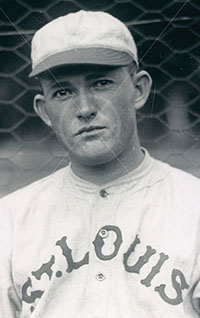
Young Rogers Hornsby
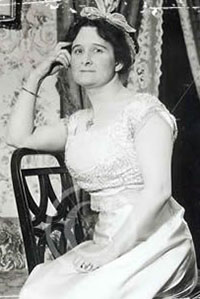
Helene Hathaway Britton, owner of Cardinals after death of her husband
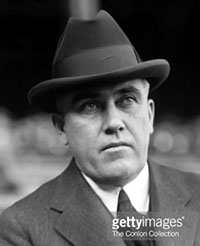
Bob Connery
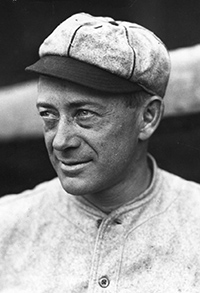
Miller Huggins, Cardinals manager
|
Player-manager Rogers Hornsby led the Cardinals to the 1926 World Series championship in the franchise's first appearance in the Fall Classic.
- He is considered by many to be the greatest right-handed hitter in baseball history.
- But he was a driven man who had almost no interests outside of baseball and gambling on horse racing and few friends in or out of his sport.
- To say he lacked tact would be an understatement.
- But if you wanted a hitting machine in your lineup, he was your man.
Rogers was a Texan through and through.
- Born in 1896 on a farm in western Texas, Hornsby was given his mother's maiden name as his first name.
- His father died at age 41 when Rogers was only two and a half years old, leaving his widow to raise five children under the age of 15.
- When Rogers was six, Mary Hornsby moved her brood to the little city of Fort Worth.
That was the age when he started playing baseball.
- Within three years, he led a semiorganized team whose uniforms were sewn by his mother.
- By age 15, Hornsby was good enough to play with grown men on a team in the city league, sometimes being paid $2 per game.
- Rogers could play any of the nine positions. "I had trouble swinging the bat," he recalled years later, "but I could field ... I could always field."
- He also played both baseball and football at the new North Side High.
- But he dropped out of school after two years to get a job and help support his family.
- His mother encouraged him to follow in the footsteps of his older brother Everett and play professional baseball.
The younger Hornsby, age 18, had to travel to Oklahoma to find a job in baseball.
- He played for Hugo OK in the Class D Texas-Oklahoma League, the lowest rung of organized baseball. His salary? $75 a month. His position? Shortstop.
- When the Hugo team folded a third of the way into the season, his contract was sold to Denison TX in the same league for $125.
- He hit only .232 and committed 45 errors in 113 games on the rocky and skinned diamonds prevalent at that time.
- Determined to succeed, he lamented to a teammate, "Won't somebody teach me how to hit?"
When he returned to Denison for the 1915 season, his salary soared to $90 per month.
- As luck would have it, the St. Louis Cardinals trained that spring in Hot Wells TX just outside San Antonio.
- Running one of the poorest franchises in the majors, Cardinal management decided the team could not afford to sign players in the upper minor leagues. So they instructed their only scout, Bob Connery, to look for "a kid who might help us" in the low minors.
- When his team broke camp, St. Louis manager Miller Huggins broke his squad into two groups.
- He led the regulars in exhibition games in larger cities on their way to St. Louis. Meanwhile, Connery took charge of a second team that played in smaller places, including a three-game set at Denison against the local team.
- That gave Hornsby a chance to play against "what I thought was a big-league team. It was my big break."
- Holding his bat at the end and taking full swings, Rogers didn't impress Connery as a batter. But as the scout remembered years later, "The more I looked at the kid, the better I liked him. He was green and awkward but possessed a great pair of hands. He fielded bad hoppers neatly and got the ball away quickly."
- Bob liked what he saw so much that he bought Hornsby a new glove and pair of shoes out of his own pocket in one of the greatest examples in baseball history of a small investment producing giant dividends.
Denison won the 1915 Western Association pennant.
- The Sporting News listed less than a dozen players from the league who had major league potential. But one of them was Denison's shortstop, "who is only a kid yet and may need a little more seasoning."
- At season's end, the Cardinals, at Connery's recommendation, bought Rogers's contract for $600.
- He was ordered to join the ballclub immediately in Cincinnati. He would receive $200 for the rest of the season.
- Why did the Cardinals, who would finish sixth that season, jump the newly-signed player from Class D to the big leagues? 1915 was the second season of the Federal League, which had signed many players away from the National and American Leagues. A financially-troubled team like the Cardinals literally had to scrape the bottom of the barrel to fill out their roster.
- Like so many players of that era, the first game Hornsby played in with the Cardinals was the first major league game he had ever seen. The trip to Cincinnati also marked the first time he had ever been north of Tulsa.
- When the Cards returned to St. Louis, the rookie repeatedly got lost in the city of more than 700,000 even though he didn't travel outside his immediate neighborhood.
- Standing 5'11" but weighing only 135 pounds, Rogers played in 18 games the rest of the season, hitting .246 with two doubles and four RBI as Manager Miller Huggins gave him a good look at shortstop.
Huggins has been called a combination of Joe Torre and Tony La Russa. Like Torre, he was a talented Cardinals player who also would manage the team before becoming skipper of the Yankees and taking them to multiple pennants and World Series titles. Like La Russa, he held a law degree.
- That he hit that much was a tribute to the work that Huggins and Connery did with him after games. They moved him closer to the plate and had him choke up on a thick-handled bat - the accepted style in that Dead Ball Era.
- In the field, he showed the same overanxiousness and erratic throwing arm that had plagued him at Denison.
At the end of the season, Huggins summoned Hornsby and told him, "Kid, you're a little light, but you got the makings. I think I'll farm you out for a year."
- Rogers interpreted what his manager told him literally. "I was just a country boy, with only three or four weeks in the big cities," he remembered. "So I took him at his word."
- He worked on his uncle's farm south of Austin through the fall and winter helping with the chores and eating steak and fried chicken and "all the milk I could hold."
- As a result, he gained 30 pounds by the time he reported to spring training in 1916.
Reference: Rogers Hornsby: A Biography, Charles C. Alexander (1995)
|
As the 1916 season approached, the Cardinals nearly sold young SS Rogers Hornsby.
- Since St. Louis had secured an option to buy a promising SS named Roy Corhan from San Francisco of the Pacific Coast League, they offered to sell Hornsby to Class A Little Rock for $500, which was $100 less than what the club had paid for Hornsby's contract the year before.
- But Little Rock passed on the deal because the price was too steep.
The National and American League franchises were overjoyed that the Federal League, which had stolen players and jacked up player salaries the last two season, had folded.
- Hornsby signed a contract for $2000 for the '16 season. The salary was predicated on his making the club.
- When manager Miller Huggins saw Hornsby when he reported to spring training, he dropped any thoughts of trading the youngster.
- The 30 pounds Rogers had put on in the off-season greatly increased his power at the plate. One writer observed: Hornsby was hardly recognized when he appeared. He has grown from a gangling boy into a well-developed physical speciman. ... It's all good, solid weight, too. The additional poundage has made him much stronger.
- Hornsby also surprised Huggins by returning to the batting style he'd used at Class D Denison. He stood in the batter's box as far back and away from the plate as possible. He stood upright and held the bat at the end. To protect against outside pitches, he put his left foot closer to the plate than his right and stepped into the pitch at a 45° angle.
- He took a full swing at the ball with his 36", 38-40 ounce thin-handled bat.
- Everyone stopped to watch the youngster driving balls to all parts of the field.
- Huggins, still skeptical of Rogers' future at SS, spoke of him as having great promise at 3B.
- Hornsby solidified his spot in the lineup by slapping five singles and three doubles in five games against the Browns in the intercity series that ended the preseason.
- Hornsby's confidence, which bordered on cockiness, irritated some of his veteran teammates. But they could abide it if he continued his hot hitting when the season started.
And that he did.
- He batted .313 in 139 games, the highest average on the club. That was also 66 points than the average for the entire NL.
- He smacked 17 doubles, 15 triples - tops on the Redbirds, and 6 HRs - tied for the most on the team.
- He also drove in 65, quite a good figure for a SS. He even stole 17 bases.
- Rogers fielded better at 3B (.934) than Corhan did at SS (.917).
- By the end of the season, Hornsby had established himself as one of the outstanding young players in the NL.
- Huggins called his hot-cornerman "the greatest free-swinging hitter in baseball." Writers compared Hornsby to Browns' 1B George Sisler, who hit .305 in his first full ML season that year.
- In mid-August, Cubs owner Charles Weeghman sent the Cardinals an offer to buy Hornsby. Brooklyn also floated a deal, offering to trade SS Ollie O'Mara and OF Casey Stengel for Hornsby and $20,000.
- But owner Helen Robison Britton, who declared herself president of the club after her divorce was finalized, stated that she would sell or trade any player on her club except Hornsby. In fact, she said she wouldn't trade Rogers for the entire Cubs roster.
But what Helen really wanted to do was rid herself of her unprofitable ball club.
- So she sold the team to a syndicate of 110 St. Louis businessmen for $250,000.
- One of the new owners' first moves would put the Cardinals on a course that would make them one of the most successful franchises in the majors within ten years.
- They lured 35-year-old Branch Rickey away from the Browns' front office by offering him a three-year contract that paid $15,000 annually.
- Hornsby expected a significant raise from Rickey, who was serving as what a later era would call the General Manager. Rogers wanted nothing less than $4,000, double what he made the year before. But even in his short tenure with the Browns, Branch had established a reputation for being tight with the dollar.
- Wanting his best player to be happy, Huggins interceded with his new boss and arranged a compromise. Rogers signed for $3,000. It wasn't near the $15,000-20,000 salaries of stars like Ty Cobb, Tris Speaker, and Walter Johnson but wasn't bad at all for a second-year player.
The war in Europe and the possibility of America's participation in it cast a spectre over the 1917 season.
- Back at SS after the Cardinals jettisoned Corhan, Hornsby raised his average to .327 - highest on the club by 30 points.
- His 24 doubles, 17 triples, and eight roundtrippers also topped the lineup, and he led the lead with 253 total bases.
- Rogers was a fan favorite despite his erratic fielding - he committed the third-highest number of errors in the league.
- The Cards won 22 more games (82) than in '16 and moved up to 3rd place in the National League.
- The result was good news for the new owners as attendance increased by 64,000. That allowed Rickey to declare a $20,000 profit and a small dividend for the stockholders.
- However, Miller Huggins was unhappy. Not liking the new ownership and upset that Rickey had been hired to take over salary negotiations, Huggins turned down a $10,000 offer to return and jumped to the American League Yankees, then a mediocre franchise at best, for $12,500 per year. He also took with him ace scout Bob Connery, who had discovered Hornsby deep in the Heart of Texas.
- Cubs owner Weeghman redoubled his efforts to obtain Hornsby, offering $75,000. But Rickey turned him down.
- Rogers received good news in January 1918 when his draft board in Fort Worth placed in Class 3 - deferment - because he provided the sole support for his mother and sister after his father's death during the past season.
To be continued ...
Reference: Rogers Hornsby: A Biography, Charles C. Alexander (1995)
|
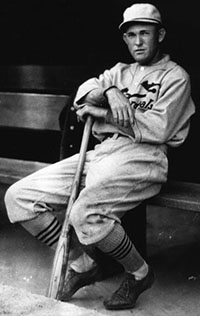
Rogers Hornsby 1916
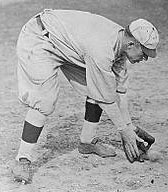
Roy Corhan
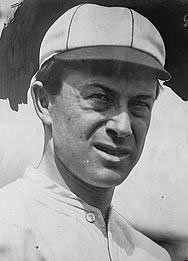
Miller Huggins
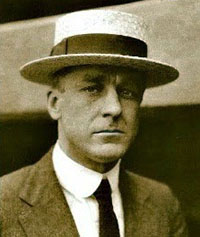 Branch Rickey
|

Jack Hendricks
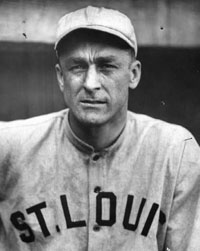
Manager Branch Rickey
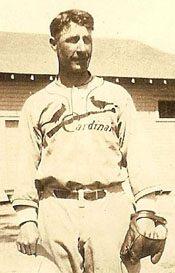
Burt Shotton
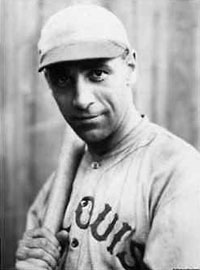
John "Doc" Lavan
|
Rogers Hornsby entered the 1918 with a new two-year contract from GM Branch Rickey at $4,000 per year.
- The contract also included a clause that prohibited trading Hornsby without his consent.
- So Rogers arrived at Hot Wells TX for spring training for his third full big-league season weighing a happy 183 pounds.
However, the season was not a happy one for Hornsby or baseball in general.
- Rogers didn't adjust well to new manager Jack Hendricks after two years under future Hall-of-Famer Miller Huggins. At one point, Rogers - never one to suffer fools wisely or hold his tongue - called Hendricks "a boob manager"
- Playing SS again, he hit only .281, 46 points lower than 1917. He drove in 60 (compared to 66 the year before) and scored just 51, 35 less than '17.
- He was plagued by injuries - a groin pull, a sore shoulder, and a spike wound in right thumb
- Part of the reason his totals were short was the fact that baseball shut down in early September because of World War I after the Cards played 129 games.
- The Cardinals won only 39.5% of their games in '18 after crafting a .539 winning percentage in '17.
- To make matters worse, Hornsby's draft board in Texas notified him that he was now Class 1. That made him the first ML player to be ordered either to "engage in an essential wartime occupation" or enter military service.
- However, he managed to stay with the team until the end of the shortened season under a dispensation from the War Department that allowed players to continue with their clubs through Labor Day.
- When the season ended, Hornsby announced that he would never play for Hendricks again.
- Rogers then went to work in a Delaware shipyard to avoid joining the army.
- When World War I ended in November - much sooner than anyone expected, Hornsby and his new wife headed home to Texas.
In January, the Cardinals Board of Directors paid off Hendricks for the rest of his contract and offered the job to Rickey.
- Just home from service in Europe, Branch reluctantly agreed to take on both jobs - manager and president, the latter position including the job that today is known as General Manager.
- Over the winter, Rickey picked up old friend Burt Shotton on waivers from the American League and John "Doc" Lavan. Shotton would be Rickey's Sunday manager in addition to playing the outfield and Lavan would take over at SS.
- Branch approached his new job in his usual meticulous manner, schooling his charges on the nuances of each position in spring training and installing a complicated set of signals.
- He worked long and hard training Hornsby for his new position, 2B. Irritated at first by the change, Rogers respected Rickey's knowledge enough to accept his coaching.
- However, Hornsby played 2B in only 27 games. He spent most of his time at 3B with occasionally forays to 1B and his old spot, SS.
- The Cardinals suffered through another poor season. Only a late season spurt kept them out of the cellar. They finished with a 28-79 record and 7th place.
- Although baseball overall bounced back from the financially-disastrous war year of 1918, the Cardinals finished last in the NL in attendance, compounding Rickey's problems as president.
- Rogers had a bounce back season. He hit .318 with 32 extra-base hits.
A major change in management affected the Cardinals during the off-season.
- The Board gave Rickey another three-year extension on his contract as president and manager.
- However, in January 1920, stockholder Sam Breadon loaned the club $18,000 on condition that he be named president of the franchise. Needing the money, the Board agreed and demoted Rickey to vice-president.
- Breadon, who made his fortune as a pioneer in the automobile business, proved to be even tighter with a dollar than Rickey.
Rickey's primary off-season task was to fend off the Giants, who made an unprecedented offer for his 2B.
- John McGraw's club wanted Hornsby so badly they offered $70,000 plus 1B George Kelly, 2B Larry Doyle, a sub outfielder, and any of their catchers.
- When Rickey rejected that offer, Giants owner Horace Stoneham put $300,000 on the table. Further, the Cardinals could keep Hornsby for the 1920 season, then receive another $50,000 for him if the Giants won the pennant.
- Showing the acumen that would make him a baseball legend, Rickey indicated that he might be interested in an arrangement that include Frank Frisch, a 21-year-old infielder out of Fordham University.
- But New York manager John McGraw - a shrewd judge of talent himself - rejected that ploy.
- In the end, Hornsby signed a one-year contract with the Cardinals for $5,000, a raise of $1,000.
To be continued ...
Reference: Rogers Hornsby: A Biography, Charles C. Alexander (1995)
|
As players reported to spring training for the 1920 season, two topics dominated baseball scuttlebutt.
- Rumors persisted that something fishy had happened in the 1919 World Series when the Cincinnati Reds upset the Chicago White Sox.
- There was also considerable talk that a new type of baseball would be used in the new season, one that was more tightly wound and therefore more lively. Also the stitches were sewn flush with the cover, which prevented curve ball hurlers from getting as good a grip.
- One change that would definitely affect play was the decision of the owners to outlaw the spitball and other trick deliveries except for 17 designated spitballers (including the Cardinals' Bill Doak) who would be allowed to continue to play their trade until they retired.
When the season began, it quickly became obvious that the new baseballs as well as the prohibition against tampering with the horsehide were producing more runs and home runs and higher batting averages.
- Compared to 1917, the last season before World War I interrupted play and siphoned off a number of players, runs scored in 1921 increased by 28% in the National League. The 1917 HR total for the two leagues was 338. By 1921, that figure had risen to an astoundig 937. From 1919-1921, batting averages jumped 31 points for NLers and 24 for ALers.
Additional changes that helped hitters were club owners' willingness to let fans keep balls fouled into the stands. Also, as a result of the fatal beaning of Ray Chapman in 1920, umpires exchanged smudged and scuffed baseballs for fresh ones.
- Cardinals 2B Rogers Hornsby benefitted as much as anybody as a comparison of his 1919 and 1920 stats shows.
| Year |
BA |
H |
R |
2B |
3B |
HR |
RBI |
| 1919 |
.318 |
163 |
68 |
15 |
20 |
8 |
71 |
| 1920 |
.370 |
218 |
96 |
44 |
18 |
9 |
94 |
The bold numbers led the league.
- The Cubs' great P, Grover Cleveland Alexander, praised Rogers as "the greatest hitter I've ever had to face. I've tried to fool him every way possible, but it just cannot be done. Personally I don't think a more skillful man ever stepped up to the plate."
- The Redbirds moved up to 5th in the NL, almost reaching .500 with a 76-78 record.
- More importantly for a franchise with financial troubles, attendance nearly doubled from 167,059 in 1919 to 326,836.
1920 began a string of spectacular seasons by the player who is still acclaimed by many to this day as the greatest right-handed hitter in baseball history.
Rogers Hornsby 1921-1926
| Year |
G |
BA |
H |
R |
2B |
3B |
HR |
RBI |
Record |
Finish |
| 1921 |
154 |
.397 |
235 |
131 |
44 |
18 |
21 |
126 |
75-79 |
3rd |
| 1922 |
154 |
.401 |
250 |
141 |
46 |
14 |
42 |
152 |
85-69 |
3rd |
| 1923 |
107 |
.384 |
163 |
89 |
46 |
10 |
17 |
83 |
79-74 |
5th |
| 1924 |
143 |
.424 |
227 |
121 |
43 |
14 |
25 |
94 |
65-89 |
6th |
| 1925 |
138 |
.403 |
203 |
133 |
41 |
10 |
39 |
143 |
77-76 |
4th |
| 1926 |
134 |
.317 |
167 |
96 |
34 |
5 |
11 |
93 |
92-61 |
1st |
The Cardinals' improved play was the result of two major factors.
- Sam Breadon, who bought the franchise in 1920, brought greater financial resources that allowed him, first of all, to pay off the club's debt.
- Rickey wisely invested some of Breadon's money in several minor league clubs, using them to develop talent in what would come to be known as a "farm system."
- As better players made it onto the Cardinals' roster, attendance increased, thus providing Rickey with more cash to further improve his roster.
Throughout this period, Hornsby had a running feud with owner Breadon. The bone of contention was, of course, salary.
All of Hornsby's numbers dropped during the 1923 season as the Cards fell from 3rd to 5th.
- Besides his ongoing marital problems, Hornsby clashed with manager Branch Rickey. The friction came into public view during an August game in the Polo Grounds against the Giants.
- Reaching 3rd base, Hornsby yelled for the batter to drive him in. But with the count at 3-1, Rickey gave the "take" sign from the dugout. Hornsby threw up his hands in a gesture of frustration and disgust. He didn't score, and the Cards dropped another game.
- In the dressing room afterward, Rickey sharply reminded Hornsby who was manager. Rogers responded with what the devoutly religious manager described as "vile and unspeakable" language. Enraged, Rickey charged at Hornsby and tried to throw a punch as Rogers pushed him away. Other players grabbed Branch and held him until he regained his composure.
- When the Cardinals returned to St. Louis, rumors swirled that Rickey would trade Hornsby. But Breadon issued a statement that the Rickey-Hornsby incident was "a closed incident" that "came about in the heat of battle." He added, "Hornsby is not for sale or trade."
- Perhaps because of the turmoil in his life, Hornsby developed a severe skin rash on his chest and shoulders and sat out an entire series in Philadelphia. He also complained of persistent pain in his knee that he had injured four months earlier.
- But the Cardinals management decided Hornsby was dogging it, and Breadon announced on September 27 that his star 2B was fined $500 and suspended for the remaining five games of the season. "Hornsby was able to play yesterday [against Brooklyn]," said Breadon, "and he should have played."
- The bottom line for the season was that attendance dropped by more than 200,000, leaving the club $14,000 in the red.
- An unhappy Hornsby announced that he didn't want to play for Rickey any more, but he'd rather play in St. Louis than anywhere "because the people ... have been wonderful to me."
Continued below ...
Reference: Rogers Hornsby: A Biography, Charles C. Alexander (1995)
|
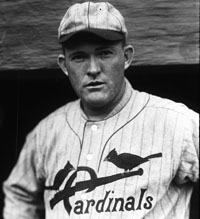
Rogers Hornsby
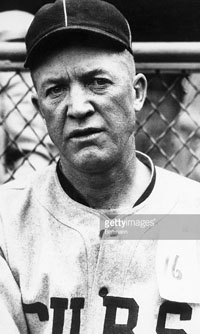
Grover Cleveland Alexander
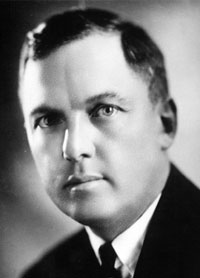
Sam Breadon
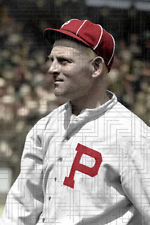
Gavvy Cravath
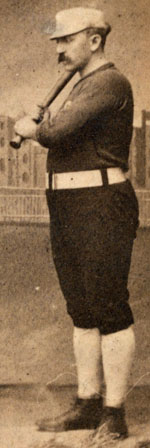
Ned Williamson
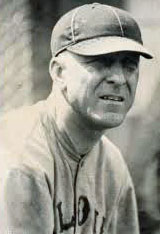
Branch Rickey 1921
|
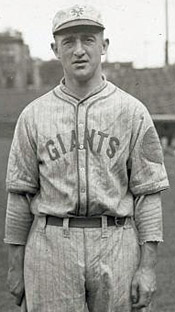
Frankie Frisch
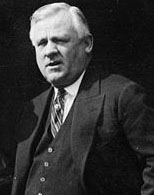
John McGraw

Branch Rickey

Sam Breadon
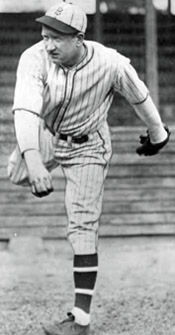
Dazzy Vance
|
In the offseason before the 1924 campaign, the Cardinals made a serious effort to grant Rogers Hornsby's wish to be traded.
- Prolonged negotiations with the New York Giants failed to produce a deal because manager John McGraw refused to part with his captain and favorite player, 2B Frankie Frisch. McGraw told the press, So far as I am concerned, the proposed deal for Hornsby is off for all time ... I wouldn't trade Frisch for Hornsby or any player in baseball.
- Soon afterward, manager Branch Rickey summoned reporters in St. Louis to announce that he and Hornsby had reached "a settlement or whatever you call it" to end their feud. Hornsby added, There is no longer any misunderstanding between us. I want to have the best year in baseball I have ever had and I want the Cardinal club to have the best year it has ever had.
Rogers improved his own performance considerably from 1923.
- Remarried right before the season began, he hit .424, his high average to that point in his career.
- That led the league as did his 227 H, 121 R, 43 2B, 373 TB, and 89 BB. He also finished 2nd in the league in HRs with 25.
The high point in Rogers' season was an incredible series against the Giants at Sportsman's Park in August when the Cardinal 2B punished the team that wouldn't trade for him by smacking 13 hits in 14 ABs. NL President John Heydler, who watched the performance, proclaimed Hornsby "the greatest batsman of all time."
- St. Louis sportswriter John B. Sheridan described Hornsby's unique approach to hitting like this: Rogers used a thin-handled bat with a big knob, held it at the end and stood as far back and way from the plate as he could and still remain inside the batter's box. He used his bat like a golf driver, its weight and thus its "driving power" concentrated in the end, and attacked the ball not as most men did - by stepping toward the pitcher - but by stepping toward the plate at right angles to the pitcher. He was an outstanding curveball hitter who rarely pulled a ball down the left field line but could hit with power to all fields.
- Hornsby himself explained his hitting philosophy like this. A batter should never at any time change his style of batting to meet just one certain condition. He should perfect his style, and stick to it in all details.
- As a 2B, Rogers didn't have much range but everyone agreed that he was one of the best at pivoting to turn the double play - in part because, with a runner on 1B, he liked to "cheat" in from the outfield grass and toward 2B.
Despite his great performance, the Cardinals did not improve.
- They fell from fifth place in '23 to sixth place with a 65-89 record.
- When the team quickly fell out of contention, Rickey and owner Sam Breadon decided to go with youth.
The end of the season brought controversy over the MVP balloting. A committee consisting of one reporter from each of the eight NL cities ranked 10 players from 10 points to 1. The player with the most points was P Dazzy Vance, who went 28-6 to help the Brooklyn Robins finish 2nd. The Cardinals had no argument with the result until they found out that the Cincinnati voter didn't include Hornsby in his Top Ten. When confronted, Jack Ryder explained, This contest supposedly is for a player who is most valuable to his team. I will concede Hornsby is a most valuable player to himself, but not to his team. On that basis I couldn't give him a solitary vote.
1924 marked the last year of Rogers' three-year contract worth $18,500 per year.
- He wanted another three-year deal for a lot more money.
- Keeping Rickey out of the loop, Breadon and Hornsby quickly settled on $100,000 for 1925-27. That figure compared favorably the contract for any other player in baseball except for the immortal Babe Ruth, who was in the middle of a five-year deal paying him $52,000 annually.
Rickey named Hornsby team captain as the 1925 spring training began.
- When the Cardinals started 13-25, Breadon pulled the plug on Branch as manager and elevated Hornsby to the position.
Breadon made the decision when he checked on pregame sales for a Sunday home game and learned that almost no tickets had been sold. He then took the train to Pittsburgh where the Cards were playing and told Rickey he was fired. Branch urged the owner to promote his coach, Burt Shotton, but Fred was sold on Rogers, who accepted the job with no increase in salary provided Sam persuaded Rickey to sell his stock to the 2B.
- In contrast to Rickey, who was criticized for "overmanaging," Hornsby cut down the number of meetings to just one at the beginning of each series to go over the scouting report on the opponent.
- He also urged his players to follow the same rules he personally followed. Concerned about harming his eyes, he never went to the movies or even read a book. He also went to bed early each night.
- He instituted $50 fines for each P when the batter hit an 0-2 pitch and for any batter who took a 3rd strike with a runner on 2nd or 3rd.
- The club responded to his leadership by winning 64 and losing 51 the rest of the way to move up to 4th with a 77-75 mark.
- The burden of managing had little effect on Hornsby's batting prowess. He surpassed the .400 mark for the third time in four years, finishing at .403 to lead the league for the sixth straight season. He also led the league in HR (39), RBI (143), and Total Bases (381).
The stage was set for the greatest season in the Cardinals' 27-year history.
To be continued ...
Reference: Rogers Hornsby: A Biography, Charles C. Alexander (1995)
|
|
|




















